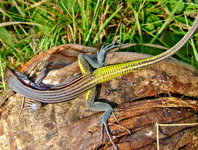Abstract
The new genus Guasuctenus gen. nov. is described based on the results of a recent phylogenetic analysis. This phylogeny, which included representatives of all Ctenidae subfamilies, showed that the genus Ctenus as currently defined, does not comprise a monophyletic group. The results indicated that several species are misplaced in Ctenus and should be transferred to new genera. Aiming to correct the placement of two species originally described in Ctenus, we propose the new genus Guasuctenus to accommodate those species and better represent their phylogenetic relationships. Guasuctenus is supported by the presence of a dorsal cymbial projection in the male palp. Previously regarded as a subspecies, Ctenus longipes vittatissimus Strand, 1916 is here ranked as species, and Guasuctenus longipes (Keyserling, 1891) new comb. and G. vittatissimus (Strand, 1916) new rank, new comb. are redescribed. Ctenus griseus Keyserling, 1891 is recognized as a junior synyonym of Ctenus longipes Keyserling, 1891. Lectotypes and paralectotypes of Guasuctenus vittatissimus (Strand, 1016) are designated for stability. The species of the genus are distributed in southern Brazil and Uruguay.
References
Álvarez-Padilla, F. & Hormiga G. (2007) A protocol for digesting internal soft tissues and mounting spiders for scanning electron microscopy. Journal of Arachnology, 35, 538–542.
https://doi.org/10.1636/Sh06-55.1
Brescovit, A.D. & Simó, M. (2007) On the Brazilian Atlantic Forest species of the spider genus Ctenus Walckenaer, with the description of a neotype for C. dubius Walckenaer (Araneae, Ctenidae, Cteninae). Bulletin of the British Arachnological Society, 14, 1–17.
https://doi.org/10.13156/arac.2007.14.1.1
Griswold, C.E. (1993) Investigations into the phylogeny of the lycosoid spiders and their kin (Arachnida: Araneae, Lycosoidea). Smithsonian Contributions to Zoology, 539, 1–39.
https://doi.org/10.5479/si.00810282.539
Hazzi, N.A., Polotow, D., Brescovit, A.D., González-Obando, R. & Simó, M. (2018) Systematics and biogeography of Spinoctenus, a new genus of wandering spider from Colombia (Ctenidae). Invertebrate Systematics, 32, 111–158.
https://doi.org/10.1071/IS17022
Henrard, A. & Jocqué, R. (2017) Morphological and molecular evidence for new genera in the Afrotropical Cteninae (Araneae, Ctenidae) complex. Zoological Journal of the Linnean Society, 180, 82–154. [supplement]
https://doi.org/10.1111/zoj.12461
Hijmans, R.J., Guarino L., Cruz, M. & Rojas, E. (2001) Computer tools for spatial analysis of plant genetic resources data: 1. DIVA-GIS. Plant Genetic Resources Newsletter, 127, 15–19.
Jiménez, M.L., Berrian, J.E., Polotow, D. & Palacios-Cardiel, C. (2017) Description of Califorctenus (Cteninae, Ctenidae, Araneae), a new spider genus from Mexico. Zootaxa, 4238 (1), 97–108.
https://doi.org/10.11646/zootaxa.4238.1.7
Keyserling, E. (1891) Die Spinnen Amerikas. Brasilianische Spinnen. Nürnberg 3, 1–278.
Mello-Leitão, C.F. de (1931) Arachnidos do Rio Grande do Sul. Boletin Biologico Rio de Janeiro, 17, 10–14.
Mello-Leitão, C.F. de (1936) Contribution à l’etude des Ctenides du Bresil. Festschrift Embrik Strand, 1, 1–31.
Pickard-Cambridge, F.O. (1897) On cteniform spiders from the lower Amazons and other regions of North and South America, with a list of all known species of these groups hitherto recorded from the New World. Annals and Magazine of Natural History, Series 6, 19 (109), 52–106.
https://doi.org/10.1080/00222939708680507
Pickard-Cambridge, F.O. (1902) New species of spiders belonging to the genus Ctenus, with supplementary notes. Annals and Magazine of Natural History, Series 7, 9 (54), 401–415.
https://doi.org/10.1080/00222930208678611
Polotow, D. & Brescovit, A.D. (2009) Revision and cladistic analysis of Isoctenus and description of a new neotropical genus (Araneae, Ctenidae, Cteninae). Zoological Journal of Linnean Society, 155, 583–614.
https://doi.org/10.1111/j.1096-3642.2008.00452.x
Polotow, D. & Brescovit, A.D. (2014) Phylogenetic analysis of the tropical wolf spider subfamily Cteninae (Arachnida, Araneae, Ctenidae). Zoological Journal of the Linnean Society, 170, 333–361.
https://doi.org/10.1111/zoj.12101
Silva Dávila, D. (2003) Higher-level relationships of the spider family Ctenidae (Araneae: Ctenoidea). Bulletin of the American Museum of Natural History, 274, 1–86.
https://doi.org/10.1206/0003-0090(2003)274<0001:HLROTS>2.0.CO;2
Simó, M. & Brescovit, A.D. (2001) Revision and cladistic analysis of the Neotropical spider genus Phoneutria Perty, 1833 (Araneae, Ctenidae), with notes on related Ctenidae. Bulletin of the British Arachnological Society, 12, 67–82.
Strand, E. (1909) Neue oder wenig bekannte südamerikanische Cupiennius- und Ctenus-Arten. Zoologische Jahrbücher, Abteilung für Systematik, Geographie und Biologie der Tiere, 28, 293–328.
Strand, E. (1916) Systematische-faunistische Studien über paläarktische, afrikanische und amerikanische Spinnen des Senckenbergischen Museums. Archiv für Naturgeschichte 81, 1–153.
Trillo, M.C., Laborda, A., Francescoli, G. & Eisenberg, A. (2018) Fifty shades of silk: sexual behavior and bridal veil deposition in the spider Ctenus longipes. Acta Ethologica, 22, 47–56.
https://doi.org/10.1007/s10211-018-0306-7
World Spider Catalog (2019) World Spider Catalog. Version 19.5. Natural History Museum Bern. Available from: http://wsc.nmbe.ch, (accessed 23 January 2019)

